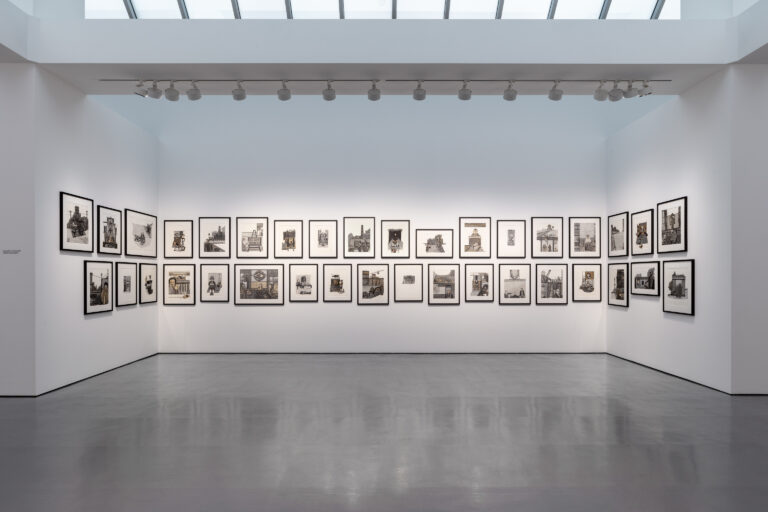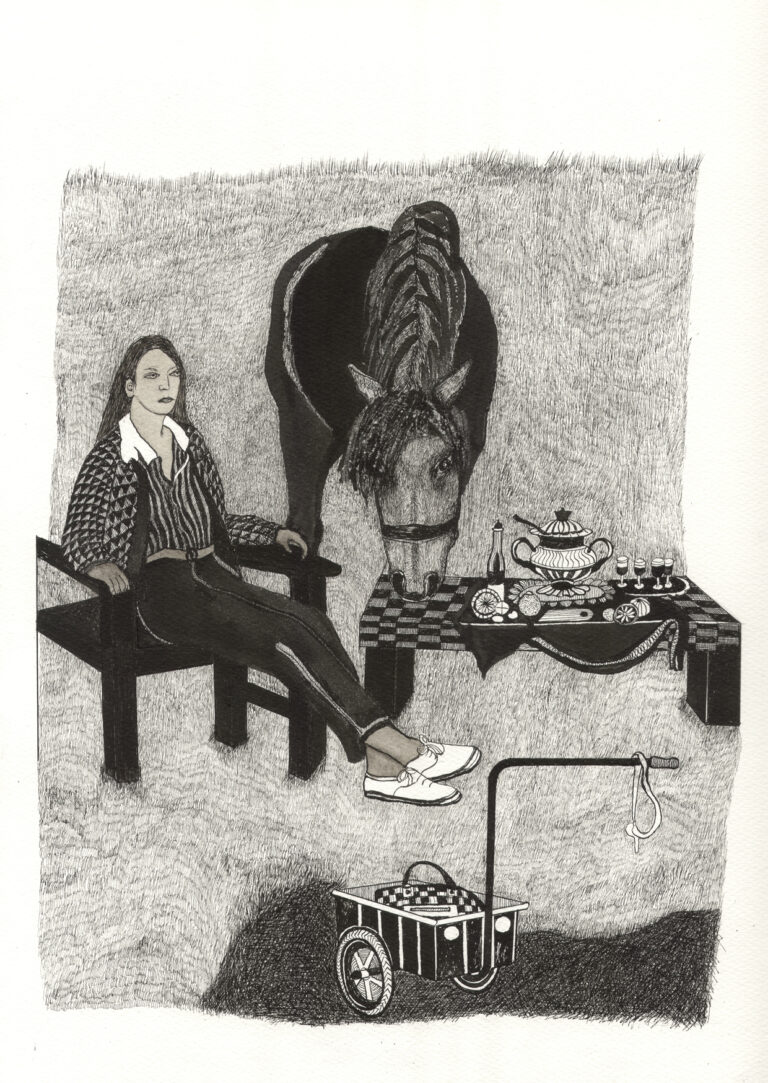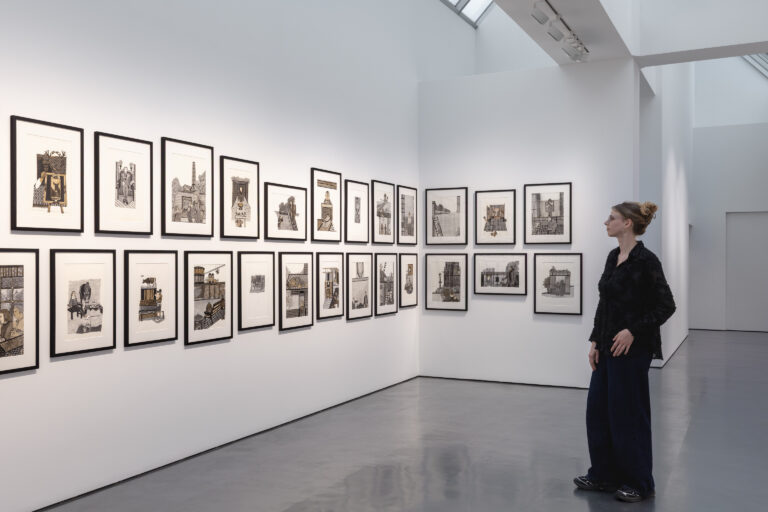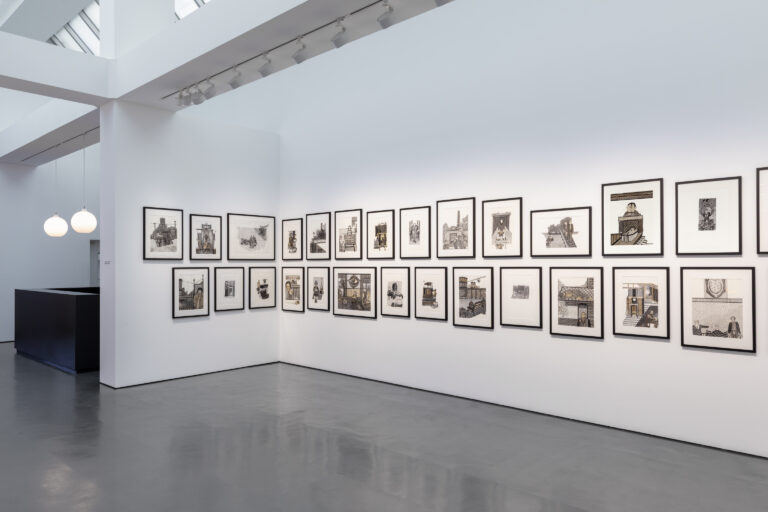Elisabeth Schrader
Lieber woanders
19 JUL until 30 AUG 2025
Please note, the gallery will be on summer break August 4 – 18. During this time visits are only possible by appointment.

Exhibition view: Elisabeth Schrader, Lieber woanders,
Esther Schipper, Berlin, 2025
Courtesy the artist and Esther Schipper, Berlin/Paris/Seoul
Photo © CHROMA
Esther Schipper is pleased to announce Lieber woanders, an exhibition by Elisabeth Schrader. On view will be works on paper spanning the years 2005-2013.
The world we encounter in Elisabeth Schrader’s drawings is both strange and familiar. Crocheted blankets, carpets, wall paneling, or tiled floors, their intricate pattern dense and sometimes slightly claustrophobic, circumscribe spaces that can feel domestic and fantastic. These interiors are depicted in fragments, some blend the outside and inside, as if entire rooms had been transported into the street; some are reminiscent of doll houses whose roof is removed so we may can look into them. The figures—men, women, sometimes children, often animals—seem arrested in a timeless space, caught in a temporal vacuum. Yet, there is an intensity: they appear engaged in a watchful state of examining the world around them, intensely focused on their activities, and deep in thought. And many are looking back at us.

Elisabeth Schrader, Tee ist fertig, 2008,
india ink on paper, 45,4 x 30,5 cm (17 7/8 x 12 in)
(unframed) (ESC 029)
© the artist
For Schrader, similar to other artist’s of her generation, in the middle of her life other roles—as wife, mother, and daughter—took precedent. This experience makes itself present in the drawings in mood and sentiment but also in the frequency of domestic motifs. Her drawings create an idiosyncratic alternative world full of coffee pots, teasets, set tables, chairs and sofas that loom large. As the exhibition’s title suggests, an ongoing theme of the drawings is an intensely felt interiority: imagining a life beyond the confines of these rooms. One senses in these closely observed scenarios an impulse to liberate oneself from these interior’s restrained and with it from the smallness of bourgeois society. Dreaming herself away from drudgery and claustrophobia, Schrader uses humor as mitigating influence: her titles add a layer of dry humor that softens the sting—or deliver it.
Schrader’s prolific and original output is unadulterated by outside influences. There surely was a steady dialogue with her husband, Hinnerk Schrader who was also an artist and who sometimes prepared the grounds of her drawings, that sustained both. Thus one finds traces of her partner’s sustained exploration of the work of Goya in Elisabeth’s style. Executed in black and sepia-colored ink, the densely patterned surfaces and muted palette have a quality of etchings. And the Spanish artist’s sense of the simultaneity of the grotesque and comical, of farce and tragedy, echoes through her drawings of estranged domesticity with their incongruous assemblies of woman, man, pet or beast. There are also her own constant looking, searching and learning. Going to museums, amassing a library of catalogues, collecting materials for her objects during her vacations, photographing her surroundings during trips and excursions. Her lifelong fascination with Egyptian, art for example, is noticeable in the patterning of all surfaces and their frieze-like stillness and two-dimensionality, especially in the rendering of the figures. The faces—human and non-human—have a directnesss and a monumentality that is reminiscent of the figures in those enigmatic ancient friezes.
Elisabeth Schrader has an extensive oeuvre of drawings, sculptures, installation and assemblage which she worked on throughout her life. Born 1935 in Barcelona, she went to art school and studied first in Hanover and then Kassel (with Fritz Winter), getting a degree in art education. Married to a fellow artist, Hinnerk Schrader, who also taught art at high school, family life centered on the arts, frequently traveling to museums both near their home close to Hanover and throughout Europe. Even as both worked as teachers, both continued to practice as artists with an earnest seriousness and fury. For Elisabeth Schrader caring full-time for her three daughters, and her six-year work on a catalogue raisonne of her husband’s work after his early death in 1989, interrupted the steady production. After her early retirement from teaching in 1995, another period of intense focus on her work commenced. Now 90 years old, Elisabeth Schrader has produced an impressive and many-faceted life’s work.

Exhibition view: Elisabeth Schrader, Lieber woanders,
Esther Schipper, Berlin, 2025
Courtesy the artist and Esther Schipper, Berlin/Paris/Seoul
Photo © CHROMA

Exhibition view: Elisabeth Schrader, Lieber woanders,
Esther Schipper, Berlin, 2025
Courtesy the artist and Esther Schipper, Berlin/Paris/Seoul
Photo © CHROMA
Among the artist’s past exhibitions are: Elisabeth Schrader, vager Raum, kuratiert von Frank Hauschildt, SteDi Stiftung, Berlin (2025); Tomi Ungerer, femmes fatales, Annex der Ausstellung im Musée Tomi Ungerer – Centre international de l’illustration, Strasbourg (2014); Elisabeth Schrader, Freunde und Vollidioten, Amis et triples idiots, Atelier und Galerie Wittersdorf (2013); Es war einmal — wie es nie gewesen ist, Galerie Ute Parduhn, Düsseldorf (2012); Elisabeth Schrader, Hinnerk Schrader: Wie es ist, Schloss Landestrost, Neustadt (2010); 1. Internationalen Push-Art Berlin, Volksbühne am Rosa-Luxemburg-Platz, Berlin (2007); Elisabeth Schrader, Gehäkelte Objekte, Hermannshof, Völksen (2002); Elisabeth Schrader, Terracotta und Keramik, Galerie Hubert, Schwarmstedt (1989); Elisabeth Schrader, Hinnerk Schrader, Galerie Riedel, Schwarmstedt (1978).
